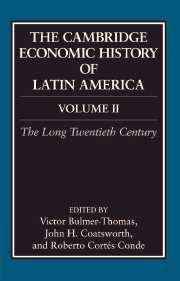Book contents
10 - Labor and Immigration
from Part III - Factor Endowments
Published online by Cambridge University Press: 28 March 2008
Summary
The role of Latin America in the international economy has changed in many ways when we compare the late nineteenth century and the late twentieth century, but in no other aspect has Latin America changed more that in its position in the international labor market. Around 1900, Latin America was the destination of millions of immigrants, particularly for millions of Europeans, and some Latin American countries were competing for labor in the international market. By the end of the twentieth century, Latin America had experienced a “population explosion” in the 1960s and the 1970s and today the region is no longer a destination for immigration. On the contrary, one of the main features of almost all Latin American countries nowadays is the high volume of emigration to the United States and Europe.
This chapter concentrates on the period in which Latin America was a major receiving area of European immigration – that is, the so-called age of mass migration between the years of 1880 and 1930. Needless to say, immigration was not a new phenomenon in the 1880s. Scattered immigrants had been arriving in the region since the 1830s and in the middle decades of the nineteenth century there were a substantial number of immigrant colonies in Brazil, Chile, Argentina, Paraguay, and Mexico. The slave trade had also been a traditional source of foreign population, particularly in Brazil and the Caribbean, and Latin America had been well integrated into the international labor market through the Atlantic slave trade. Chinese immigrants were also relatively important in Peru and Cuba.
- Type
- Chapter
- Information
- The Cambridge Economic History of Latin America , pp. 377 - 426Publisher: Cambridge University PressPrint publication year: 2006
References
- 4
- Cited by



